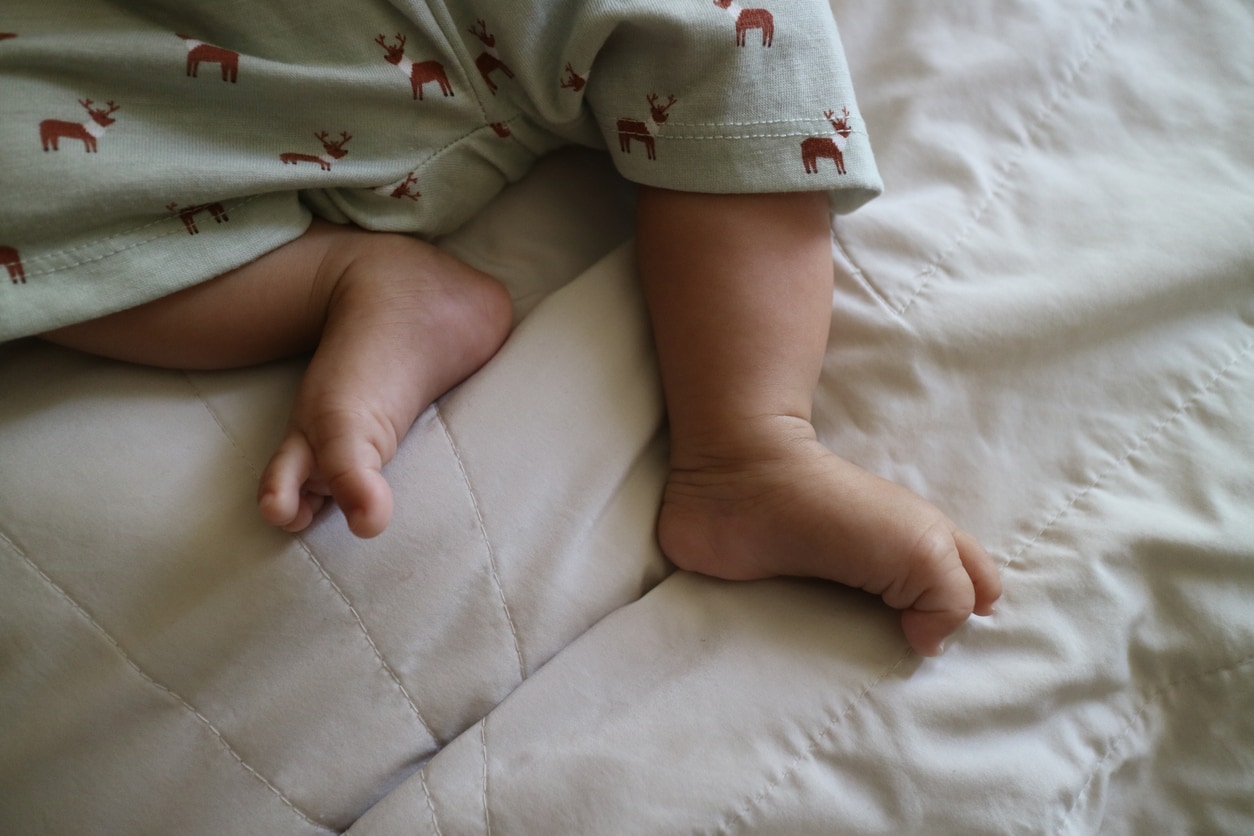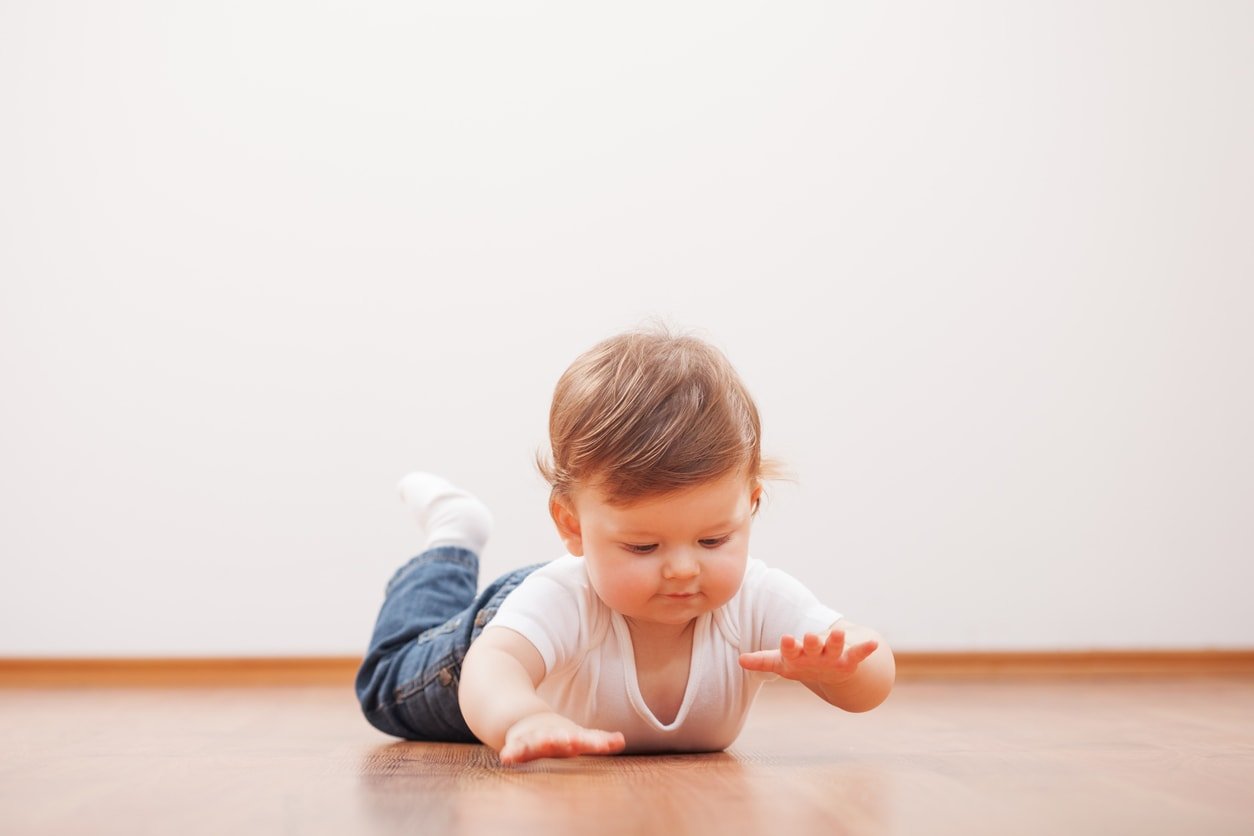
One great thing about newborns is that they stay where you put them. Until suddenly, one day, they don’t! While every baby’s motor development and trajectory look a little bit different, a baby rolling over is one of the first major movement milestones.1 Here, we will answer the question, “When do babies start rolling over?” (both from belly to back and from back to belly). We’ll also explore what milestones come before and after rolling, how to help your baby roll, safety tips, and more.
When Do Babies Roll Over?
Babies may begin to roll over as early as 4 months of age and do so more consistently by 6 months.1,2 Typically, babies roll from belly to back first.2 To roll from their bellies to their backs, gravity is on their side, so they can use the weight of their heads to tip themselves over.1 Back-to-belly rolling may follow in one to two months.2
While babies typically roll from belly to back first and subsequently from back to belly, that may sometimes be reversed because they’re spending less time in tummy time.3 We know environmental factors can influence when a baby rolls over. For instance, there is a study from China that suggests that Chinese babies first roll from back to belly instead.4
When Do Babies Roll From Belly to Back?
So, at what age do babies start to roll over in different directions? Infants may start rolling from their belly to their back in their fourth month.1 Other studies report that it is normal for them to begin rolling from belly to back any time between 4 and 6 months of age.5
When Do Babies Roll From Back to Belly?
Your pediatrician will tell you that most babies roll from back to belly by around 6 months of age. In fact, a study examining the use of different muscle groups in infant rolling showed that all different styles of back-to-belly rolls occurred in each infant participant’s sixth month.5 However, as mentioned above, there are environmental factors that can lead babies to roll one way or the other first, so be ready by 4 months old for either direction!
How Do Babies Learn To Roll?
Babies use their whole bodies to roll. They usually have a stationary limb to maintain balance and a moving limb to initiate the roll. Rolling gets faster as babies get better at identifying the most efficient way to do it.6 It teaches babies about gravity, balance, stability, and position. It also fosters muscle development for posture and eventually other movements like sitting, crawling, and walking.5
Signs Your Baby Is Almost Ready To Start Rolling Over

A baby’s strength develops from their head down. So, signs that your little one is close to rolling include a strengthened neck, shoulders, and core.1 Here are some specific motions, movements, and indicators that your baby is almost ready to start rolling over:1,2,5,7
- Rocking side to side or rolling onto their side
- Lifting their head in tummy time
- Lifting their chest in tummy time
- Propping themselves up on their arms in tummy time
- Reaching for toys in front of them while on their belly
- Bringing their knees to their chest when on their back
What To Do If You Suspect a Developmental Delay
If you suspect your baby should be rolling over by now but they are struggling to do so, contact your pediatrician. You will have an appointment at 4 and 6 months of age, and these are great times to discuss any concerns. You should also reach out if your baby used to be able to roll and can no longer perform this skill.8
If you can, take a video of your baby to show the provider your concerns. Your pediatrician can view this and evaluate your baby. They may simply reassure you that your baby is on the right track or suggest exercises or referrals to experts for early intervention therapy.8 In some states, you can also self-refer if you are concerned.9 (Check your state’s early intervention resources on the CDC’s website.)
How To Help Baby Roll Over

Naturally, you want to help your child roll because it’s new and exciting! Rolling demonstrates a purposeful, goal-oriented movement from your little one. It enables and encourages exploration and interaction with their environment in a new way. Rolling is as much cognitive as it is motor and requires full body coordination and movement.5 To help get your baby rolling over, you need to give them the space, environment, and encouragement to do so. Here are some ways you can encourage rolling:
Tummy Time
Even a few minutes per day in tummy time can help your baby accelerate in achieving rolling and crawling milestones.1 Tummy time gives your baby the opportunity to strengthen the muscles necessary for rolling and puts them in the correct position to roll. They can also practice shifting weight back and forth in tummy time.7
Floor Time
Tummy time is not the only beneficial floor time for babies who are trying to roll. Even laying on their backs, babies spending time loose on the floor can encourage rolling. Conversely, spending too much time in containers such as swings, car seats, carriers, and cushions can delay rolling.10
Place your baby on the floor or another firm, flat surface. This will give them the free reign to strengthen their muscles and explore their bodies’ capabilities.5 It’s important that the surface is flat; one study showed that an inclined surface doubled the required muscle activity to achieve a roll.11
Motivation
While your baby is on the floor, try placing toys, books, or other safe items to one side, just out of their reach. This may encourage them to reach with their arms and shift their weight enough to get them to roll over.2
Practice and Assistance
You can place your baby on their back on the floor and rock them side to side to get them used to the feeling of rolling. From tummy time, you can gently guide them into a roll to their back. Finally, try placing your baby on their side and see if they can complete the roll!7
Encouragement and Praise
Singing, cheering, and clapping are great forms of motivation and positive reinforcement. In a moment when your baby is close to rolling, encourage them. If they achieve a roll, celebrate! Any visual or verbal encouragement or reward is motivating and helpful for your baby to want to continue learning how to roll.7
What To Do If Your Baby Is Rolling Over in Their Sleep

If your baby begins rolling over in their sleep, it’s time to stop swaddling them. Their arms need to be loose for them to roll freely in either direction once they’re able to. If your baby rolls onto their stomach while sleeping but can’t roll back, you can reposition them (although you don’t need to wake up to check on this). Once they have demonstrated the ability to roll in both directions, you can leave them in whatever position they achieve on their own. However, you should still place them on their backs initially when putting them down for sleep.12 Once my babies learned to roll, they always slept on their stomachs, but I still laid them down on their backs at the start of the night.
Safety Tips for When Your Baby Is Rolling Over
Once your baby reaches this milestone, you must start paying attention to their surroundings. As I said, they don’t just stay wherever you put them anymore! Their newfound mobility introduces several new dangers to be aware of. Here are some risks to consider and safety tips for how to prevent harm:
Falling
Do not leave your baby unsupervised on an elevated surface they could roll off of, such as a bed or changing table. If you’re using a changing table, use the safety strap and always remain with baby. Prepare in advance by keeping all the supplies for a diaper change within your reach.13 I always ended up changing my daughters’ diapers on the floor!
Choking
Around the same time your baby starts rolling over, they will likely start to bring everything to their mouth.14 Therefore, ensure you clear their area (and any surrounding spaces they may be able to roll to) of all potential choking hazards. This includes small toys, tops and lids, hairbands and bows, balloons, coins, tools, batteries, and food items within reach of baby.15
Strangulation
Infants can get accidentally tangled in long ropes, cords, and strings. Keep them away from window blind cords, electronic wires, and other strangulation risks.12
Suffocation
Ensure that your baby’s sleep surface is firm and flat and that their bed is free of loose blankets, crib bumpers, and other soft, thick materials. These materials are more likely to cause pockets of air that your baby’s face could get stuck in. This causes them to rebreathe their same air, leading to suffocation. A fitted sheet and a sleep sack are all you need.12
Entrapment
Ensure your baby’s mattress fits snugly in their crib or bassinet, and only use a mattress designed for your specific crib so that they cannot roll off the mattress and get stuck between it and the edge of the crib. Additionally, ensure the slats of your crib are less than 2 ⅜ inches apart to avoid any limbs getting stuck. The crib should not have drop sides or any missing pieces or parts, even if it has been repaired.12
Baby Is Rolling Over: What Milestone Comes Next?

After babies start rolling, a whole cascade of major motor milestones follow in the first year of life. Most often, babies begin to sit with — and eventually without — support. Next, they may crawl on their hands and knees or stand with support. Finally, they will walk with assistance, stand alone, and walk alone.16
Rolling is just the start of an exciting year of new movements and milestones with your baby. If you’re wondering what age babies roll over at, look out for this milestone when they’re around 4 to 6 months old. If they are not there yet, there are many ways to encourage rolling. And if you are still concerned, reach out to your pediatrician. Once your baby is rolling, then sitting, crawling, and walking will follow before you know it. As thrilling as all this movement is, make sure to babyproof your house, and always practice safe sleep.
from Baby Chick https://ift.tt/KGqzvR2
via IFTTT


0 Comments
Please ,
Don't enter span link ...